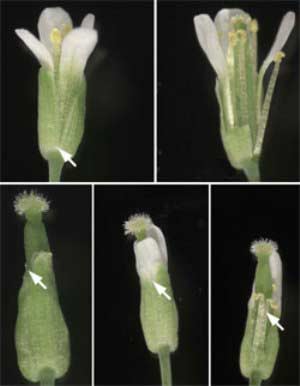Researchers at the Rice University and MIT’s Whitehead Institute for Biomedical Research have discovered that microRNA plays a crucial role in gene expression. First identified several years ago, scientists worldwide are racing to find and study microRNA—small RNA segments that regulate gene expression in both animals and plants.
 |
(Photo: sciencedaily) |
It is believed that there are hundreds of microRNAs present in each species of plants and animals, but very few of their functions are known.
According to a recent study by biologists at Rice University and the Whitehead Institute for Biomedical Research at the Massachusetts Institute of Technology, one of the first groups to explore microRNA in plants, a specific RNA known as miR164 plays a vital role in the proper development of flowers, leaves, and stems in Arabidopsis.
“We have known that the miR164 gene exists in several other flowering plants and in rice. This gene has been conserved over more than 250 million years of evolution,” stated Bonnie Bartel, an associate professor of biochemistry and cell biology at Rice and co-author of the study. “Our research has uncovered that this small RNA segment is an essential regulatory component of the molecular circuitry that governs the development of the plant’s basic organs.”
The study involved experiments on three lines of Arabidopsis: one normal (or wild-type) line and two mutant lines created in the laboratory. In the first mutant line, miR164 was “super-expressed”, produced in much greater quantities than normal. In the second mutant line, the target gene of miR164 was resistant to regulation by miR164, allowing researchers to observe the outcomes when miR164 regulation was absent.
Researchers found that in both cases, the leaves and flowers developed abnormally. When the regulation of the target gene by miR164 was lost, the plant organs were produced in unusual numbers. For instance, there could be too many or too few petals, or the protective layers surrounding the flower, resembling a husk, when it blooms. When there was an excess of miR164, the organs fused together. Petals did not separate completely; for example, stamens developed together into a mass.
RNA is the substance that translates the genetic code of DNA into proteins. Structurally, RNA is a chain of phosphate, sugar, and nucleotide molecules. The most common form of RNA, mRNA, contains thousands of nucleotides and serves as the genetic blueprint that cells use to assemble amino acids into proteins.
MicroRNA is smaller, only about 20 nucleotides long. All microRNAs “regulate down” the production of specific proteins by interfering with mRNA in various ways.
One of the mysteries is why microRNAs have been conserved for so long in evolutionary history. They are believed to have existed before animals and plants diverged into two separate evolutionary paths. By studying the functions of specific microRNAs, scientists hope to answer fundamental questions about how and why they evolved, as well as gain insights that could be applied in new agricultural and medical technologies.
Arabidopsis, a universal genetic model and one of the most studied plant species, was the first plant in which microRNA was discovered, and nearly 100 microRNAs have been identified in this species.
The research was supported by the National Institutes of Health, the G. Harold and Leila Y. Mathers Charitable Foundation, the Robert A. Welch Foundation, and the Alexander and Margaret Stewart Foundation. Co-authors include David Bartel, an associate professor of biology at the Whitehead Institute and MIT; Allison Mallory, a postdoctoral researcher at Whitehead; and Diana Dugas, a graduate student at Rice.
Nguyễn Xuân Hưng




















































